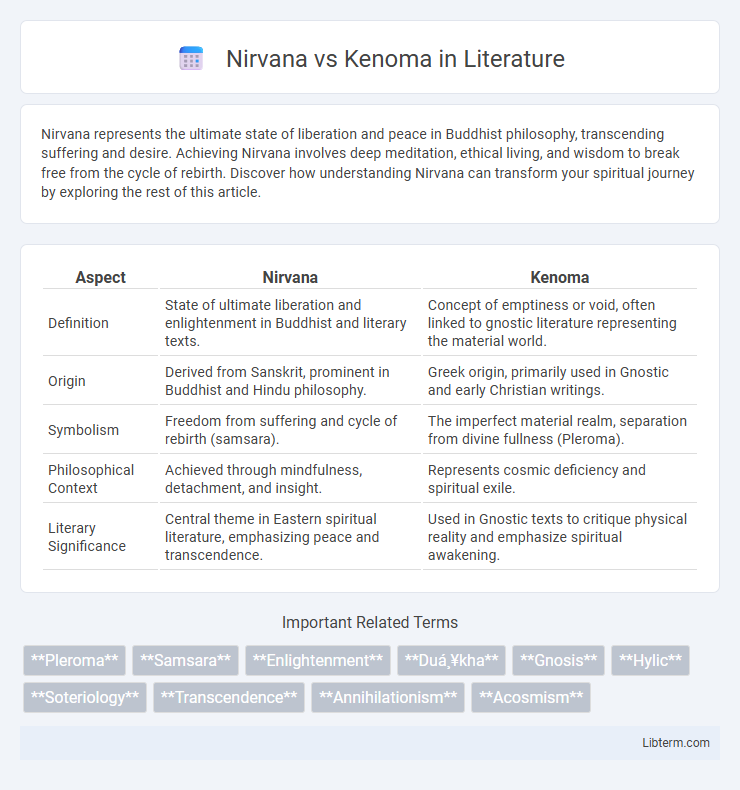Nirvana represents the ultimate state of liberation and peace in Buddhist philosophy, transcending suffering and desire. Achieving Nirvana involves deep meditation, ethical living, and wisdom to break free from the cycle of rebirth. Discover how understanding Nirvana can transform your spiritual journey by exploring the rest of this article.
Table of Comparison
| Aspect | Nirvana | Kenoma |
|---|---|---|
| Definition | State of ultimate liberation and enlightenment in Buddhist and literary texts. | Concept of emptiness or void, often linked to gnostic literature representing the material world. |
| Origin | Derived from Sanskrit, prominent in Buddhist and Hindu philosophy. | Greek origin, primarily used in Gnostic and early Christian writings. |
| Symbolism | Freedom from suffering and cycle of rebirth (samsara). | The imperfect material realm, separation from divine fullness (Pleroma). |
| Philosophical Context | Achieved through mindfulness, detachment, and insight. | Represents cosmic deficiency and spiritual exile. |
| Literary Significance | Central theme in Eastern spiritual literature, emphasizing peace and transcendence. | Used in Gnostic texts to critique physical reality and emphasize spiritual awakening. |
Understanding Nirvana: Definition and Origins
Nirvana, rooted in ancient Indian religions such as Buddhism and Jainism, signifies the ultimate state of liberation and cessation of suffering. It represents the extinguishing of desire, ignorance, and attachment, leading to profound inner peace and spiritual freedom. This state contrasts sharply with Kenoma, a term from Gnostic cosmology describing the flawed material world or emptiness, emphasizing the spiritual perfection Nirvana embodies.
Kenoma Explained: Meaning and Historical Context
Kenoma, derived from ancient Greek philosophy and Gnostic traditions, refers to a state of emptiness or void, contrasting sharply with the concept of Nirvana as spiritual liberation. Historically, Kenoma represents the material world's imperfection and incompleteness, embodying chaos and lack of divine fullness (pleroma). In Gnostic texts, Kenoma is depicted as the flawed cosmos created by a lesser deity, highlighting its significance in discussions of metaphysical dualism and spiritual enlightenment.
Philosophical Foundations: East Meets West
Nirvana in Eastern philosophy represents the ultimate liberation from suffering and the cycle of rebirth, rooted in Buddhist teachings emphasizing enlightenment and self-realization. Kenoma, a Gnostic concept from Western thought, denotes the realm of emptiness and deficiency, contrasting with Pleroma, the fullness of divine presence, highlighting dualistic metaphysics and spiritual knowledge. The philosophical foundations of Nirvana and Kenoma intersect on themes of transcendence and metaphysical emptiness but diverge through their cultural contexts and ontological frameworks, reflecting a fusion of Eastern contemplative insight and Western esoteric tradition.
Nirvana in Buddhism: Paths and Practice
Nirvana in Buddhism represents the ultimate cessation of suffering, where the cycle of birth, death, and rebirth ceases, and one achieves liberation through the extinguishing of desires and attachments. The practice leading to Nirvana involves following the Noble Eightfold Path, which includes right understanding, right intention, right speech, right action, right livelihood, right effort, right mindfulness, and right concentration. Unlike the concept of Kenoma, which denotes emptiness or void, Nirvana is a state of profound peace and enlightenment realized through disciplined meditation, ethical conduct, and wisdom.
The Concept of Kenoma in Gnosticism
Kenoma in Gnosticism represents the concept of emptiness or void, symbolizing the material world's deficiency and imperfection compared to the divine fullness, or Pleroma. It illustrates the spiritual state of alienation from true knowledge (gnosis) and the entrapment within ignorance and matter. Kenoma contrasts with Nirvana's notion of liberation by emphasizing the stark divide between the flawed physical realm and the transcendent spiritual fullness.
Core Differences: Nirvana vs Kenoma
Nirvana, in Buddhist philosophy, represents the ultimate state of liberation and cessation of suffering, where the cycle of birth and rebirth ends. Kenoma, rooted in Gnostic beliefs, describes the realm of emptiness or void, characterized by material imperfection and separation from divine fullness (Pleroma). The core difference lies in Nirvana being a transcendent state of enlightenment, while Kenoma signifies a deficient and alienated cosmic space.
Symbolism and Metaphors in Both Realms
Nirvana represents ultimate liberation and the cessation of suffering, symbolized by the extinguishing of the flame in Buddhist teachings, reflecting the metaphor of transcending the cycle of rebirth and desire. Kenoma, in Gnostic cosmology, symbolizes emptiness or voidness, often metaphorically depicted as a barren, chaotic realm contrasting with the fullness (Pleroma) of divine fullness and spiritual completeness. Both realms employ rich symbolism to express profound metaphysical states: Nirvana as the peaceful dissolution of ego and attachment, and Kenoma as the desolate space of spiritual deficiency and separation from divine light.
Impact on Spiritual Worldviews
Nirvana and Kenoma significantly influence spiritual worldviews by representing ultimate states of being and existential absence, respectively. Nirvana, rooted in Buddhist philosophy, signifies liberation from suffering and the cycle of rebirth, fostering a worldview centered on enlightenment and inner peace. Kenoma, often interpreted as a concept of cosmic void or emptiness in Gnostic traditions, challenges notions of material reality and encourages a perspective focused on spiritual transcendence and the quest for divine fullness.
Modern Interpretations: Relevance Today
Modern interpretations of Nirvana and Kenoma emphasize their relevance in contemporary spiritual discourse by highlighting Nirvana as the ultimate state of liberation and Kenoma as the manifest, imperfect world of material existence. Scholars connect Nirvana with concepts of inner peace and enlightenment sought in mindfulness practices, while Kenoma reflects ongoing struggles with existential emptiness and dissatisfaction. This duality informs modern philosophical and psychological approaches to understanding human suffering and transcendence.
Choosing a Path: Personal Reflection and Conclusion
Choosing between Nirvana and Kenoma involves deep personal reflection on one's spiritual goals and understanding of existence. Nirvana represents liberation from suffering and the cycle of rebirth, symbolizing ultimate enlightenment in Buddhist philosophy. Kenoma refers to the concept of emptiness or void, often interpreted in Gnostic traditions as a state of spiritual exile or potential transformation, requiring introspection to determine which path aligns best with one's quest for meaning.
Nirvana Infographic

 libterm.com
libterm.com